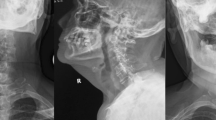Abstract
Purpose
High-grade C1C2 luxation is a rare pathology. There is no clear evidence as to how to treat this deformity. There is only limited evidence about the different surgical techniques and possible approaches including advantages, disadvantages, and complications.
Methods
This is an uncommon case of a 13-year-old child with progressive, tetraplegia due to congenital os odontoideum with translational instability between C1 and C2, and progressive luxation of C2. An irreducible dislocation of the C0/C1 complex caused significant compression at the cervicomedullary junction and neurologic deficit. In this paper we highlight the different types of os odontoideum, a review of existing evidence of surgical correction. We will discuss the different treatment strategies which could be applied and the current solution will be described.
Results
Continuous skeletal traction and translational reduction was achieved by a specially designed halo traction system including continuous skeletal traction in a wheelchair for 6 weeks. The surgical treatment consisted of a posterior only release, translational reduction and posterior instrumentation from C0 to C4 with a Y plate and homologous bone graft. Neurological deficits started to improve during halo traction. After surgery the patient was ambulatory without any assistance and reached a Frankel stage E. Postoperative X-rays and CT scan revealed complete reduction at the C1/C2 level and a decompressed cervicomedullary junction.
Conclusion
Treatment of severe C1C2 luxation is difficult with limited evidence in the literature. The current case shows a successful treatment strategy to reduce the deformity and lists alternative approaches.








Similar content being viewed by others
References
Matsui H, Imada K, Tsuji H (1997) Radiographic classification of os odontoideum and its clinical significance. Spine 22:1706–1709
Menezes AH, Ryken TC (1992) Craniovertebral abnormalities in Down’s syndrome. Pediatr Neurosurg 18:24–33
Pueschel SM, Scola FH, Tupper TB (1990) Skeletal anomalies of the upper cervical spine in children with Down’s syndrome. J Pediatr Orthop 10:607–611
Fielding JW, Hensinger RN, Hawkins RJ (1980) Os odontoideum. J Bone Joint Surg Am 62:376–383
Fielding JW, Griffin PP (1974) Os odontoideum: an acquired lesion. J Bone Joint Surg Am 56:187–190
Kirlew KA, Hathout GM, Reiter SD, Gold RH (1993) Os odontoideum in identical twins: perspectives on etiology. Skeletal Radiol 22:525–527
Klimo P Jr, Kan P, Hrao G, Apfelbaum R, Brockmeyer D (2008) Os odontoideum: presentation, diagnosis, and treatment in a series of 78 patients. J Neurosurg Spine 9:332–342
Maeda T, Saito T, Harimaya K, Shuto T, Iwamoto Y (2004) Atlantoaxial instability in neck retraction and protrusion in patients with rheumatoid arthritis. Spine 29(7):757–762
Spierings EL, Braakman R (1982) The management of os odontoideum. Analysis of 37 cases. J Bone Joint Surg Br 64B:422–428
Jeanneret B, Magerl F (1994) Primary posterior fusion C1/2 in odontoid fractures: indications, technique, and results of transarticular screw fixation. J Spinal Disord 5:464–475
Watanabe M, Toyama Y, Fujimura Y (1996) Atlantoaxial instability in os odontoideum with myelopathy. Spine 21:1435–1439
Choit RL, Jamieson DH, Reilly CW (2005) Os odontoideum: a significant radiographic finding. Pediatr Radiol 35:803–807
Stevens JM, Chong WK, Barber C, Kendall BE, Crockard HA (1994) A new appraisal of abnormalities of the odontoid process associated with atlanto-axial subluxation and neurological disability. Brain 117:133–148
Anderson RC, Ragel BT, Mocco J, Bohman LE, Brockmeyer DL (2007) Selection of a rigid internal fixation construct for stabilization at the craniovertebral junction in pediatric patients. J Neurosurg 107 (1 Suppl):36–42
Crawford NR, Hurlbert RJ (2002) Anatomy and biomechanics of the craniocervical junction. Semin Neurosurg 13:101–110
Brockmeyer D, Apfelbaum R, Tippets R, Walker M, Carey L (1995) Pediatric cervical spine instrumentation using screw fixation. Pediatr Neurosurg 22:147–157
Kim IS, Hong JT, Jang WY, Yang SH, Sung JH, Son BC, Lee S (2011) Surgical treatment of os odontoideum. J Clin Neurosci 18(4):481–484
Menezes AH (2008) Surgical approaches: postoperative care and complications transoral-transpalatopharyngeal approach to the craniocervical junction. Childs Nerv Syst 24:1187–1193
Limpaphayom N, Skaggs DL, McComb G, Krieger M, Tolo VT (2009) Complication of halo use in children. Spine 34(8):779–784
Shirasaki N, Okada K, Oka S, Hosono N, Yonenobu K, Ono K (1991) Os odontoideum with posterior atlantoaxial instability. Spine 16(7):706–715
Conflict of interest
None.
Author information
Authors and Affiliations
Corresponding author
Rights and permissions
About this article
Cite this article
Bach, C.M., Arbab, D. & Thaler, M. Treatment strategies for severe C1C2 luxation due to congenital os odontoideum causing tetraplegia. Eur Spine J 22, 29–35 (2013). https://doi.org/10.1007/s00586-012-2329-5
Received:
Accepted:
Published:
Issue Date:
DOI: https://doi.org/10.1007/s00586-012-2329-5




